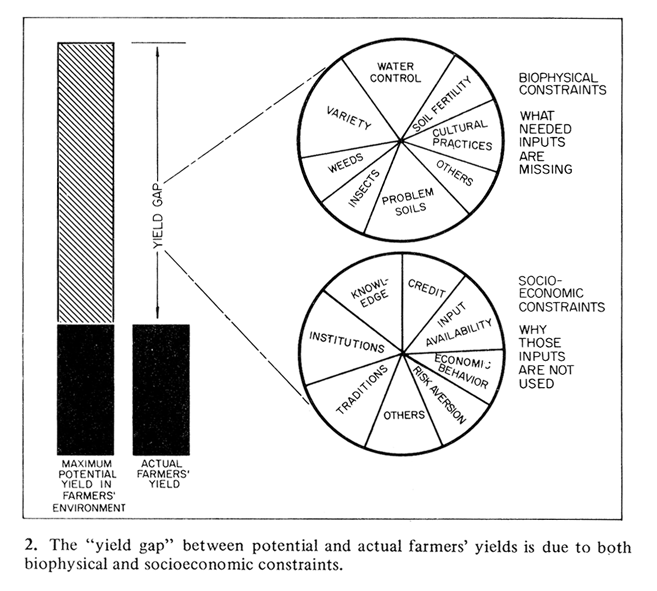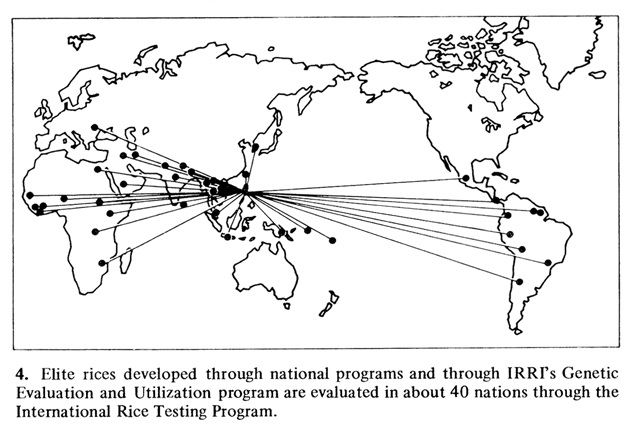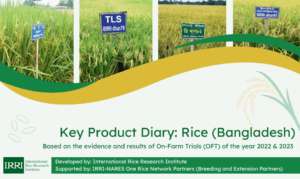During 1974, we at IRRI have given considerable thought to how we can more effectively help the world’s small farmers increase their rice production. Despite productivity increases, the Green Revolution technology has bypassed many other less prosperous areas. The semidwarf rices developed at IRRI are unsuitable for many vast “deep water” regions of Thailand, Bangladesh, India, Burma, Indonesia, and Vietnam. Similarly, high-yielding rices are needed for the salty soils of coastal marshes and of irrigated land in arid regions, and for the drought-prone regions where upland rice is grown. The improved rices developed for all areas must be resistant to major insects and diseases. Nine interdisciplinary teams of plant breeders and problem-area scientists, such as pathologists, entomologists, agronomists, and soil chemists, are working together to develop rices that are genetically adapted to each of the major types of growing conditions in which rice is produced.
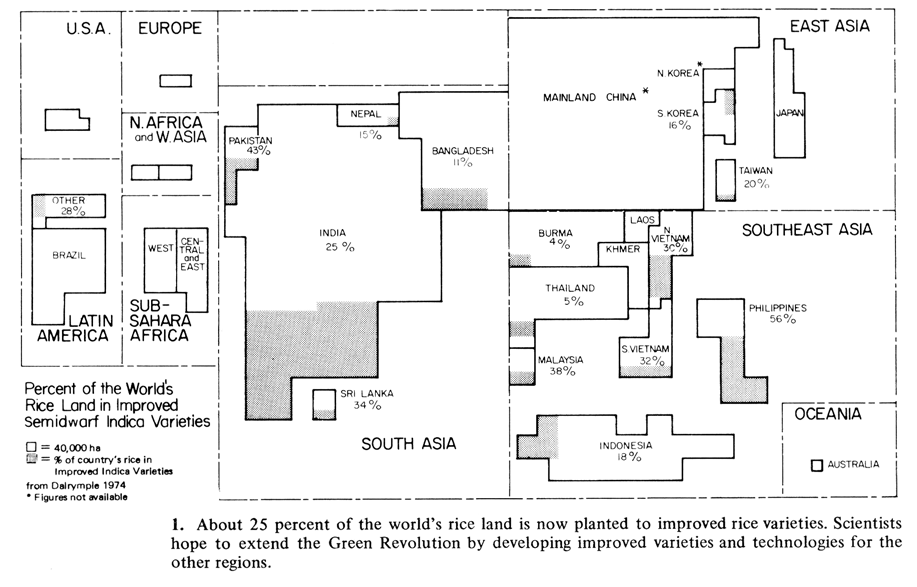 During the past year, we at IRRI have given considerable thought to how we can more effectively help the world’s small farmers increase their rice production.
During the past year, we at IRRI have given considerable thought to how we can more effectively help the world’s small farmers increase their rice production.
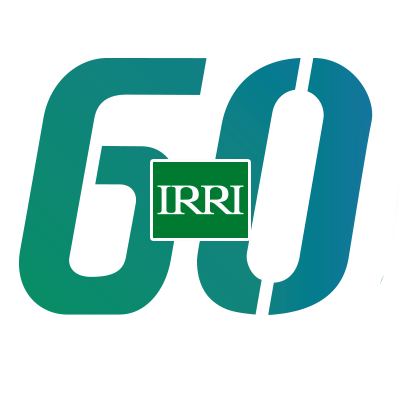 We know that farmers have adopted the new varieties on only about a fourth of the world’s rice land. Even in some countries where the new rices are widely grown, rice production has increased far less than anticipated.
We know that farmers have adopted the new varieties on only about a fourth of the world’s rice land. Even in some countries where the new rices are widely grown, rice production has increased far less than anticipated.
We also know that on a substantial portion of the world’s rice land – estimates range from half to three-fourths – farmers can’t increase production much because no improved varieties and technology are available that are suited to their areas.
We have concluded that to be more effective, we must take three steps:
First, we must work closely with farmers to determine their constraints. We must find out why they have not adopted the new technology, or if they have adopted it, why their yields are so low;
Second, we must organize our internal research and training programs to encourage interdisciplinary attacks on farmers’ problems in the field; and
Third, we must better couple our research and development programs with those of cooperating scientists and educators in the rice-growing countries, for theirs is the ultimate task of developing and adapting the technology needed to feed a hungry world.
We made some progress in each of these areas in 1974. These efforts complemented the traditional flow of new varieties and technology from the fields, greenhouses, and laboratories of the Institute.
In 1974, we intensified and expanded our research to better understand what prevents small farmers from producing yields as high as we know are attainable with the new technology.
We are concerned with both biophysical and socioeconomic factors. The bio-physical aspect of the yield gap indicates what inputs are missing. It measures the extent to which yields would increase if farmers would use improved varieties, apply optimum levels of fertilizers and pesticides, correct soil problems, and use the best cultural practices. The socioeconomic analysis indicates why the farmer may not be using the bio-physical technology. Reasons may include input costs, market prices, inadequate knowledge, inadequate credit, or traditional beliefs.
Because the yield-gap factors differ from area to area, an important aspect of our program is developing and sharing reliable research methodology to help local scientists in many nations identify local production constraints, so they can then overcome them.
Our research shows that diseases and insects are obviously major constraints to rice yields. In six experiments on farmers’ fields in Laguna province, Philippines, for example, insect damage reduced yields by an average of almost 1.7 t/ha.
Other major constraints are inadequate water and weed control, and inadequate fertilizer use.
We continued to develop and formalize interdisciplinary team attacks on rice production problems in 1974. Our reasoning is simple: the problems that face small farmers are varied and complex. No single discipline – nor any single research institution – has the ability to tackle them. Only a team effort, each scientist contributing his specialized knowledge and skills, can produce the wide range of varieties and technology needed to really intensify food production.
Our two largest teams are those concerned with the Genetic Evaluation and Utilization (GEU) program and with the Cropping Systems program. Together, they account for more than half of IRRI’s total research and training efforts.
Genetic Evaluation and Utilization (GEU) Program is an interdisciplinary rice improvement effort, linked with similar national programs in Asia, Africa, and Latin America, to jointly develop and evaluate improved rices and technology for all rice-growing areas. The GEU program builds on the success of the semidwarf varieties that have so remarkably increased production in those areas where farmers are assured of water control and adequate chemical inputs.
Despite these productivity increases, the Green Revolution technology has bypassed many other less prosperous areas. The semidwarf rices developed at IRRI are unsuitable for many vast “deep water” regions of Thailand, Bangladesh, India, Burma, Indonesia, and Vietnam. Similarly, high-yielding rices are needed for the salty soils of coastal marshes and of irrigated land in arid regions, and for the drought-prone regions where upland rice is grown. The improved rices developed for all areas must be resistant to major insects and diseases.
Through the GEU program, nine interdisciplinary teams of plant breeders and problem-area scientists, such as pathologists, entomologists, agronomists, and soil chemists, are working together to develop rices that are genetically adapted to each of the major types of growing conditions in which rice is produced. The problem areas for which GEU teams are seeking improved rices are:
- Agronomic characteristics;
- Resistance to insects;
Resistance to diseases; - Tolerance to drought;
- Tolerance to adverse soils;
- Tolerance to deep water and floods;
- Tolerance to extreme temperatures (cold or hot);
- Grain quality; and
- Higher levels of protein
To develop improved rices, each team first identifies varieties that can withstand the major constraints to rice production within its specific problem area. Through crossbreeding, they develop large numbers of experimental lines that are resistant or tolerant to these constraints, and that have other favorable characters as well (particularly high and stable yield potential and pest resistance).
Each team member brings his specialized background knowledge into the breeding and evaluation program.
The drought-tolerance team, for example, consists of geneticists, plant breeders, agronomists, and plant physiologists; it works closely with the disease- and insect resistance teams. In much the same manner that pest-resistant varieties were developed, the drought team is now screening, breeding, and testing to develop rices that can withstand moisture stress. They determine the abilities of traditional Asian and African varieties to survive drought, and cross them with other rices of higher yield potential. They promptly make promising lines available to cooperating scientists in regions of drought to evaluate in rigid screening trials.
The third major thrust at IRRI is to initiate and expand international networks, uniting the research and development efforts of scientists from a number of cooperating countries.
Four such collaborative networks have been established among cooperating biological and social scientists across the rice-growing world: 1) the International Rice Testing Program, which is the evaluation component of an international GEU effort; 2) the International Agro-Economic Network; 3) the International Cropping Systems Network; and 4) the Agricultural Machinery Development Network.
Elite rices generated by the GEU program and by national rice improvement programs are evaluated under a worldwide range of environmental conditions through the International Rice Testing Program (IRTP).
Each national program can nominate its best parent materials, breeding lines, and varieties for global evaluation in the 12 yield and/screening nurseries (Table 2). Additional problem-area nurseries may be initiated as the need arises.
Worldwide testing shows how different rices react to diverse pests, diseases, and environmental conditions, and speeds up the identification of rices with yield stability. It spreads new germplasm to broaden the genetic base of the world’s rice crop.
The operation of the program is quite simple. IRRI, as IRTP coordinator, receives seeds of varieties or lines that cooperators in national centers have nominated for inclusion in the program. We multiply the seed and then compile it into sets, which are distributed to cooperators in country programs. The field tests are run by scientists in national programs who are familiar with local environmental conditions and with the habits, customs, and resources of local farmers.

